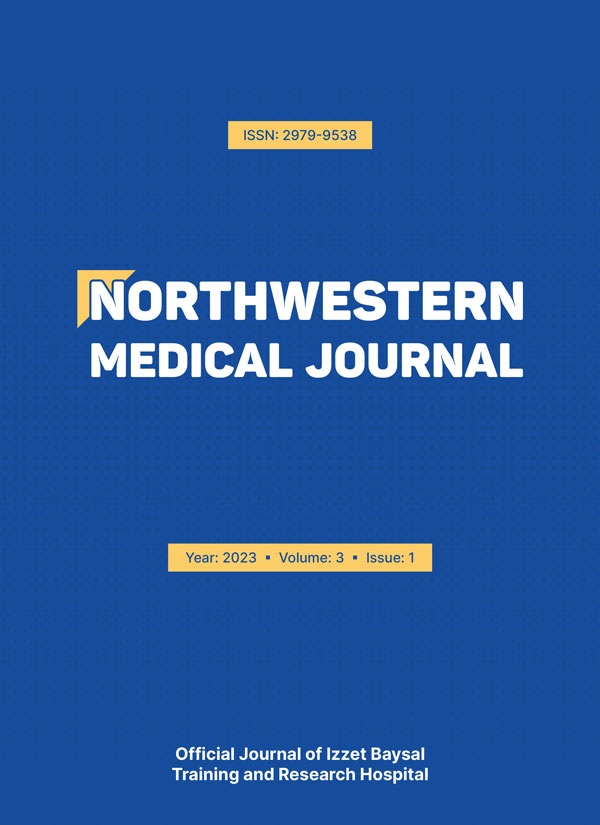Abstract
Aim: Body mass index is an important condition that may affect postoperative complications. Although there are studies on this subject in the literature, we aimed to reveal the relationship between body mass index and complications in lung cancer surgery more distinctly by limiting the factors that may directly affect postoperative complications such as operation type and staging.
Methods: Patients undergoing thoracotomy and lobectomy for early-stage primary lung cancer in our clinic between January 2014 and October 2021 were retrospectively analyzed. The demographic characteristics of the 292 patients and their body mass indexes (BMI) were grouped in line with the recommendation of the World Health Organization and analyzed in terms of postoperative complications and length of stay.
Results: The mean age of the cases was 61.93±0.55 (34-86) years, and the mean body mass index was 26.89±0.30 (16.44-58.27) kg/m². The mean BMI value was 17.40 kg/m² for group 1, 22.55 kg/m² for group 2, 27.25 kg/m² for group 3, and 33.75 kg/m² for group 4. At least one complication developed in 71.4% of the cases in group 1, these values were 58.5% - 52.8% - 35.2% for group 2, group 3, and group 4, respectively. It was determined that cases with high body mass index had a lower risk of developing complications in the postoperative period (p=0.003).
Conclusion: We found that body mass index is a factor that can give an idea about postoperative complications, prolonged air drainage, and hemorrhage in patients for whom resection is planned due to lung cancer.
Keywords: Body mass index, complication, lung cancer, thoracotomy
Copyright and license
Copyright © 2023 The Author(s). This is an open-access article published by Bolu İzzet Baysal Training and Research Hospital under the terms of the Creative Commons Attribution License (CC BY) which permits unrestricted use, distribution, and reproduction in any medium or format, provided the original work is properly cited.
How to cite
References
- Prentice AM, Jebb SA. Beyond body mass index. Obes Rev. 2001; 2(3): 141-7. https://doi.org/10.1046/j.1467-789x.2001.00031.x
- Apovian CM. Obesity: definition, comorbidities, causes, and burden. Am J Manag Care. 2016; 22(7 Suppl): s176-85.
- Jawitz OK, Wang Z, Boffa DJ, Detterbeck FC, Blasberg JD, Kim AW. The differential impact of preoperative comorbidity on perioperative outcomes following thoracoscopic and open lobectomies. Eur J Cardiothorac Surg. 2017; 51(1): 169-74. https://doi.org/10.1093/ejcts/ezw239
- Campbell PG, Yadla S, Nasser R, Malone J, Maltenfort MG, Ratliff JK. Patient comorbidity score predicting the incidence of perioperative complications: assessing the impact of comorbidities on complications in spine surgery. J Neurosurg Spine. 2012; 16(1): 37-43. https://doi.org/10.3171/2011.9.SPINE11283
- Rotman JA, Plodkowski AJ, Hayes SA, et al. Postoperative complications after thoracic surgery for lung cancer. Clin Imaging. 2015; 39(5): 735-49. https://doi.org/10.1016/j.clinimag.2015.05.013
- Flores RM, Park BJ, Dycoco J, et al. Lobectomy by video-assisted thoracic surgery (VATS) versus thoracotomy for lung cancer. J Thorac Cardiovasc Surg. 2009; 138(1): 11-8. https://doi.org/10.1016/j.jtcvs.2009.03.030
- Takenaka T, Katsura M, Shikada Y, Tsukamoto S, Takeo S. The impact of cardiovascular comorbidities on the outcome of surgery for non-small-cell lung cancer. Interact Cardiovasc Thorac Surg. 2013; 16(3): 270-4. https://doi.org/10.1093/icvts/ivs489
- Lembicz M, Gabryel P, Brajer-Luftmann B, Dyszkiewicz W, Batura-Gabryel H. Comorbidities with non-small cell lung cancer: Is there an interdisciplinary consensus needed to qualify patients for surgical treatment? Ann Thorac Med. 2018; 13(2): 101-7. https://doi.org/10.4103/atm.ATM_274_17
- Suemitsu R, Sakoguchi T, Morikawa K, Yamaguchi M, Tanaka H, Takeo S. Effect of body mass index on perioperative complications in thoracic surgery. Asian Cardiovasc Thorac Ann. 2008; 16(6): 463-7. https://doi.org/10.1177/021849230801600607
- Nakagawa T, Toyazaki T, Chiba N, Ueda Y, Gotoh M. Prognostic value of body mass index and change in body weight in postoperative outcomes of lung cancer surgery. Interact Cardiovasc Thorac Surg. 2016; 23(4): 560-6. https://doi.org/10.1093/icvts/ivw175
- Kim HE, Yu WS, Lee CY, Lee JG, Kim DJ, Park SY. Risk factors for pulmonary complications after neoadjuvant chemoradiotherapy followed by surgery for non-small cell lung cancer. Thorac Cancer. 2022; 13(3): 361-8. https://doi.org/10.1111/1759-7714.14263
- Jin R, Zheng Y, Gao T, et al. A nomogram for preoperative prediction of prolonged air leak after pulmonary malignancy resection. Transl Lung Cancer Res. 2021; 10(8): 3616-26. https://doi.org/10.21037/tlcr-21-186
- Stolz AJ, Schützner J, Lischke R, Simonek J, Pafko P. Predictors of prolonged air leak following pulmonary lobectomy. Eur J Cardiothorac Surg. 2005; 27(2): 334-6. https://doi.org/10.1016/j.ejcts.2004.11.004
- Attaar A, Winger DG, Luketich JD, et al. A clinical prediction model for prolonged air leak after pulmonary resection. J Thorac Cardiovasc Surg. 2017; 153(3): 690-699.e2. https://doi.org/10.1016/j.jtcvs.2016.10.003
- Parini S, Azzolina D, Massera F, et al. The Overweight Paradox: Impact of body mass index on patients undergoing vats lobectomy or segmentectomy. Semin Thorac Cardiovasc Surg. 2022; S1043-0679(22)00038-7.
- Zhang X, Liu Y, Shao H, Zheng X. Obesity paradox in lung cancer prognosis: evolving biological insights and clinical implications. J Thorac Oncol. 2017; 12(10): 1478-88. https://doi.org/10.1016/j.jtho.2017.07.022
- Li S, Wang Z, Huang J, et al. Systematic review of prognostic roles of body mass index for patients undergoing lung cancer surgery: does the “obesity paradox” really exist? Eur J Cardiothorac Surg. 2017; 51(5): 817-28. https://doi.org/10.1093/ejcts/ezw386
- Kavurmaci O, Akcam TI, Ergonul AG, Turhan K, Cakan A, Cagirici U. Is the risk of postoperative atrial fibrillation predictable in patients undergoing surgery due to primary lung cancer? Heart Lung Circ. 2018; 27(7): 835-41. https://doi.org/10.1016/j.hlc.2017.06.729











